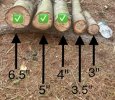mathhunter
Member
I've been looking into trying rope climbing for next year. I hunt private very close to my house, so carrying my climbing sticks out to my hunting spots isn't a big deal. However, I don't have that much time to hunt (often just a couple of hours) and I get a bit annoyed at the amount of time I spend packing and unpacking and setting up and taking down my climbing sticks. I've been watching some of the videos by JRB and I really like the idea of having paracord presets in my best spots so I can get hunting faster and then get back to time with family quicker when the hunt is done.
Anyway, I feel like I have a pretty good handle on the different climbing methods that I can use to get me up in the tree. However, I'm not completely clear on how people set up once they are up in the tree. In particular, I have the following questions:
Anyway, I feel like I have a pretty good handle on the different climbing methods that I can use to get me up in the tree. However, I'm not completely clear on how people set up once they are up in the tree. In particular, I have the following questions:
- It seems like it wouldn't be a good idea to have the rope you climbed on hanging down to the ground while you hunt. Movement you make up in the tree might shake the rope near the ground and alert a deer. Do people pull the rope up in the tree while hunting, and if so what are good ways to store the rope in the tree?
- Some of the rope climbing methods involve the rope going over a crotch in the tree that might be much higher than where you end up hunting. In these cases, it doesn't seem natural to use the rope you climbed on as a tether. Do people carry a shorter tether with them for using once they get to hunting height and then transition back to the climbing rope when they rappel down? Are there other options to use the rope you climbed on as a tether at hunting height even if the rope is going over a crotch 20 feet above your hunting height?
- Certain rope climbing methods restrict what side of the tree you will be climbing on. Are there good ways to transition to the other side of the tree for setting your platform once at hunting height?


